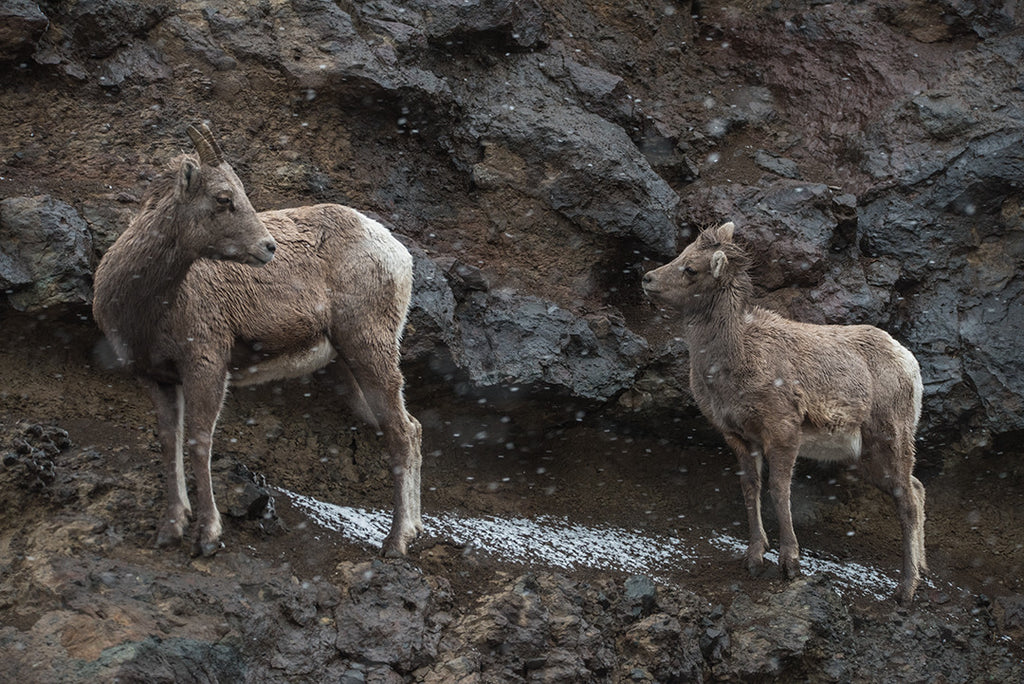It's unseasonably warm for February in Wyoming, but the wind cuts out of the west at more than 50 miles an hour as though Nature is attempting to balance herself. The mud flats at the mouth of Buffalo Bill Reservoir on the North Fork of the Shoshone River are ripped skyward, a virtual haboob sailing east over the half-open lake. High above, on the peaks of the Absaroka Beartooth Mountains, similar trails of snow twist from cornices, streaming in the gale like clouds. Tall grasses along the river, which for ten thousand years have drawn elk, deer, and bighorn sheep out of the mountains this time of year, lie flat, prostrate before the screaming wind.
It's not much of a day to take pictures, but I learned a long time ago that waiting for perfect weather in the Rocky Mountains will keep a man indoors more days than is healthy. I've made the 120-mile trip from Billings, up the Clark's Fork of the Yellowstone River, past Heart Mountain - once an internment camp for Japanese Americans during World War Two - through the town of Cody, passing close to the famous rodeo grounds, driven through the long tunnel just downstream of Buffalo Bill Dam on the North Fork of the Shoshone, into this river valley and headlong into the teeth of the windiest day of year. My truck shudders in a crosswind gust I'm guessing tops 60mph, and I grit my teeth. I'm not turning around.
Above the reservoir, where eroded pillars of lava rock reach like giant, twisted fingers more than one hundred feet high, the valley narrows and it's slightly less windy. And by slightly less windy I mean that with considerable effort I might be able to stand up without bracing myself with quite all my strength. I cruise by battered signs advertising summer trail rides, enormous log cabins sitting empty until their owners arrive in the spring, a couple of deserted fishing accesses, and a working horse ranch. All along the road mule deer lie in any depression that offers relief from the wind, tucked into the leeward side of irrigation ditches, nestling tight to summer homes, drawing close to cottonwoods along the river. Their coats are thick and sleek, the color of the snowless landscape, and many have their eyes closed.
I find my first sheep fifteen miles upstream of Wapiti, the town marked by a school and gas station. They're feeding in sage along the highway, unconcerned with me when I stop next to them. Rams and ewes and lambs - several generations - have come together here to wait out the winter. A young ram watches me suspiciously as I get out with my camera, fixing me with an eye as pretty as any in the wild. I stand still until he lowers his head and begins feeding again, approaching slowly. Behind him, a patriarch with thick, broomed horns paws through a couple of inches of crusty snow and comes up with a mouthful of grass. I fire a burst of photos, examine one to be sure my exposure is reasonably good, then zoom in on his muzzle and watch him chew. Like the white on the edges of the brook trout's fins, the muzzle of bighorn sheep is a shade of cream unique to them. I wait for this old warrior to pick his head up and look me, his bronze eyes standing in sharp contrast to his lighter, battle-scarred horns, and get a couple good photos before he ambles away.
In twenty minutes, the wind has sucked any body heat my jacket helps retain away and I'm shivering. Back in my truck, the heater cranked up, I hold my fingers close to the vent, then dig around in the back seat for my gloves. I come up with them just as a lone bison shuffles out of some willows along the river. He's come twenty-five or more miles from the edge of Yellowstone Park, pushing downstream toward open ground the way his ancestors have done for millennia.
I'm more cautious approaching the bison than the sheep, though this one is so intent of brushing snow away from the base of sage with his shaggy head that he pays no attention to me. I stop fifty feet from him, my long lens resting on my monopod, and wait for him to notice his visitor. He doesn't. Or if he does, he doesn't care. I stamp my feet, kick a woody sage beside me, and whistle. Still, nothing. This bison will not be interrupted at mealtime. Finally, I howl like a wolf, a long, drawn-out call that he understands, and he raises he head to look at me. His forehead bears the pea-green leaves of sage and grass stubble giving him an even more prehistoric appearance. I see his eyes roll and head tip - body language that says he doesn't appreciate my wolf ruse - and as soon as my shutter trips I retreat. I'm cold again anyway, and by the time I reach my truck he's gone back to feeding.
I drive on, up to where the Shoshone has carved a narrow canyon through the lava, wide enough for a highway and not much more. The next sheep I spot are bedded in rocks, rams facing away from the wind. They aren't sleeping, and as soon as I step out of my truck all heads turn in my direction. I hunch over and move slowly, my camera held against me, trying to keep as much sage between me and the sheep as I can, not lifting my head until I'm within seventy or eighty feet of where the best ram lies. Slowly, I raise my camera, frame the shot, and run off a few pictures, then zoom out to get both him and a lamb in the same photo. He poses for that shot, then stands and walks downhill toward me. As a ewe that I hadn't seen gets up between us, he postures for her and though the rut is long over rolls his head to show off his horns. He's got attitude, and I'm burning pictures as rapidly as my camera will take them. The show doesn't last long, and again I'm cold.
There's more light in the sky than a month ago, but it's still a cold, winter light, and as I come to the edge of Yellowstone Park and the end of this road, clouds hurtle overhead and grainy snow skitters along the ground. It's February, and it's nearly 70 miles back to Cody, back past the sheep I've seen, the lone bison, the bedded mule deer, and a group of cow and calf elk that's silhouetted on a wind-blown ridge. I stop twice to photograph goldeneye ducks - winter ducks that dive among floating chunks of ice - and where I sneak on them the second time I find a beautiful piece of agatized petrified wood with colors like a bighorn's eye set in the pale blue of distant mountains. It's cold in my hand and heavy in my pocket, but I like thinking I'm the first person to ever lay eyes on it and that once, back before any of this land held anything I've come to photograph, it was a tree.
That thought is still with me as I stop along the reservoir for a cold, sunset picture, and as my camera brackets a set of photos I'll blend together at some point I wonder what this country would have looked like a few million years ago. I smile thinking it may well have held creatures more formidable than the bison. And then, as the day fades behind me, I let the wind shove me east and then north toward Montana.
Look for these pictures and more in the coming days for sale here.










